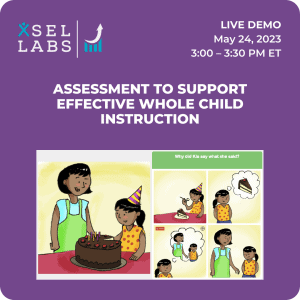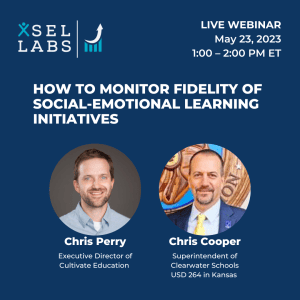All Educators Are Leaders
One important job of a leader is to make difficult decisions about where to invest scarce resources. In that sense, all educators are leaders.
Here’s a clear example: district and school leaders decide how to invest money and resources to support teaching, learning, and student outcomes. Those investments might come in the form of purchasing a social and emotional learning program or investing in teacher professional development, for example. Communities expect those investments to yield a measurable benefit.
Here’s a less obvious example: Teachers decide every day how to invest their time. Even within a prescribed curriculum, for example, they have to decide what to teach to whom at what point. Teach the right material to the right student at the right time, and students make measurable gains. Miss the mark, and learning may suffer.
What do those two seemingly distinct leadership decisions have in common? High-quality assessment data can help all educators–from district and school leaders to classroom teachers–make better decisions about what to invest in and can help them know whether they got it right.
In the field of social and emotional learning, for example, superintendents can use SEL assessment to decide what programs to invest in, teachers can use SEL assessment to decide what content to teach to whom, and both can use SEL assessment to learn whether their investments have yielded a payoff.
In other words, educators who aspire to do high-impact work in social and emotional learning can lead with data.
Leading with SEL Data at the District Office
Imagine you are a superintendent. The newly-approved district strategic plan prioritizes social and emotional learning. Your job is to make that happen.
Now imagine that all students in your district completed a high-quality social and emotional competence assessment. Imagine further that the assessment was designed to measure several key social and emotional competencies. Imagine still further that you could access easy-to-interpret reports summarizing the strengths and needs of students in the district and in each school within the district.
Armed with this information, you could engage in a data-informed discussion about the kinds of SEL programs that would be best-suited to addressing the unique needs of the learners in your district. And there are resources that can help you and your colleagues do this. Stephanie Jones and her colleagues at Harvard authored a report that included an analysis of the content focus of 25 leading SEL programs. For example, if high-quality SEL assessment data revealed that conflict resolution was an area of need, the table on page 33 suggests that “I Can Problem Solve” and “PATHS” are two programs that focus quite a bit on conflict resolution skills. They might be worth investigating further.
This does not mean that assessment data should be the only source of information for making program investments, but I do think that a discussion anchored in evidence is more likely to lead to a good decision about program investments than a data-free discussion. Without assessment data, it’s too easy for a high-profile recent event, or a vocal minority of parents or staff to sway the decision in ways that might—or might not—lead to the best instructional investment.
Leading with SEL Data in the Classroom
Now imagine you are a fourth grade teacher. Your district has just adopted an SEL curriculum and it is your first week of school. Your job is to decide how to use the curriculum to greatest effect. For example, you are faced with deciding what competencies to emphasize in your explicit instruction and as you support social and emotional development outside of SEL lessons.
As was the case when you were superintendent above, imagine all of your students completed a high-quality SEL assessment designed to measure the competencies that are the target of instruction in your district’s chosen curriculum. You receive a report that describes the strengths and needs of the class, and individual reports of student performance.
With this information, you can decide what competencies to emphasize in your instruction. Imagine, for example, that, as was the case at the district level, your class overall could use work on conflict resolution, but the lessons in your district’s program don’t focus on conflict resolution until the end of the year. You might consider either previewing the lessons on conflict resolution, or, if you prefer to maintain the lesson sequence, bringing in supplemental instructional material on conflict resolution. You might consider integrating a conflict resolution approach to literacy by asking students to describe the conflict between characters in a story and by discussing how they could work out their conflicts. You might be particularly mindful of student conflicts and coach them through those conflicts using a problem-solving approach.
Leading to Change
Leadership involves investing resources and, as the two anecdotes above illustrate, SEL assessment data can help educators lead with data. But leadership also involves seeing the investment through until it yields a return. But how can leaders know if their decisions have been beneficial?
You guessed it: Assess student competencies. If things are working, you should see consistent improvement at the student, classroom, school, and district levels in performance on social and emotional competence assessments, and other indicators of well-being.
Leading in a Crisis
It is tempting to focus only on the mental health challenges the pandemic and its consequences have created in our children, and to put out fires to the exclusion of what is arguably the less immediately pressing goal of nurturing social and emotional competencies. But, as I have argued elsewhere, even in the midst of turmoil, it’s important to play the long game, which involves equipping children with the academic, social, and emotional competencies they will need to succeed, and to thrive, even in the face of great challenge.
And it is possible to do this, even in remote instruction. As we speak, our social and emotional assessments are being administered in households around the country, supervised remotely by teachers. And creative SEL program providers like Move this World offer SEL instructional resources that are well-suited to remote instruction.
It’s understandable that the current crisis might crowd out long-term goals. But they don’t have to. And I hope they don’t. Even in this strange new world, it’s possible to lead with data, and in so doing, to make a measurable difference.



